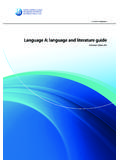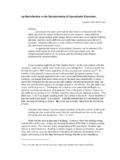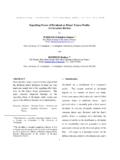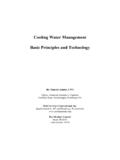Transcription of The Effects of Electric Transmission Lines on …
1 239 The Effects of Electric Transmission Lineson Property Values: A literature ReviewThomas O. Jackson* and Jennifer Pitts**AbstractThis paper presents a review of empirical studies on the Effects of Electric transmissionlines on property values. The primary purpose of these studies is to address the effectsof the presence of Transmission Lines on the value of surrounding properties. Thestudies range from survey-based research that provides important context to regressionanalyses of sales data to less formal appraisal-based sales analyses. The surveys ofmarket participants and real estate professionals found evidence of concern and atleast in one survey, an assumption that such concern would impact property noted the unattractiveness of the Transmission Lines and structures. However,most of the regression-based sales price analyses found little or no Effects on Effects that were found tended to dissipate with time and distance. Lastly, priceanalyses based on less formal paired sales and other techniques failed to find literature on the Effects of Electric Transmission Lines on property values can bedivided into three general categories.
2 The first category presents several survey-basedstudies of opinions and perceptions concerning the impacts of Transmission Lines ,although some of these studies also analyze sales prices. While stated preferences in surveys do not provide an adequate basis for estimating price Effects , surveys canand do provide important insights into the market s perception of these structures andtheir potential impacts on certain types of real property. Although adverse perceptionsby the market can lead to sales price Effects , potential Effects may be offset ormitigated by other factors influencing the pricing decisions and this likely accountsfor the lack of such findings when the preferences revealed in sales data areanalyzed. The second literature category presents empirical studies of sales priceeffects using multiple regression analysis or other closely related multivariatestatistical techniques such as analysis of covariance. Like the survey research, thesestudies primarily address single-family residential properties, although two studiesaddress impacts on rural land and agricultural properties.
3 The third literature categorycontains a mix of study types, includingpaired sales analyses, case studies, and sale/resale analyses. Many of thesestudies were conducted by and Health EffectsWhile not the primary focus of the research reviewed herein, the issue of health effectshas received some attention due to the market s purported fear of harmful exposureto electromagnetic fields (EMFs). Numerous studies have been conducted around the*Texas A&M University, College Station, TX 77843-4218 or Property Analytics, Inc., College Station, TX 77845 or Journal of Real Estate LiteratureVOLUME 18, NUMBER 2, 2010world to determine what health Effects , if any, are caused by EMF exposure. Thisresearch has employed numerous methodologies, and the findings are largelyinconclusive. In 1992, the Congress authorized the Electric and Magnetic FieldsResearch and Public Information Dissemination Program (EMF-RAPID), a six-year program of research and analysis with the purpose of providing scientific evidenceto clarify the potential for health risks from exposure to extremely low frequencyelectric and magnetic fields (ELF-EMF).
4 This research was led by the NationalInstitute of Environmental Health Sciences (NIEHS). At the conclusion of this projectin 1999, the NIEHS reported that scientific evidence linking EMF exposure to healthrisks is weak. Overall, epidemiological EMF studies show a pattern of small, increasedrisk of two types of cancers: childhood leukemia and chronic lymphocytic leukemiain adults with occupational EMF exposure. However, laboratory research fails toprovide any consistent evidence of this connection. The NIEHS determined that whileEMF exposure cannot be ruled as entirely safe, the scientific evidence of health risksis insufficient to warrant aggressive regulatory concern. Since there has been scantevidence of any actual health Effects from EMFs, any measured Effects on propertyvalues would, then, likely be due to other factors such as visual encumbrance or thephysical encumbrance of the easement area through which the Transmission Lines point is generally borne out in the studies reviewed ResearchKinnard (1967) was one of the first to undertake a comprehensive study concerningthe Effects of Electric Transmission Lines on the value of residential property.
5 Kinnardconducted a year-long survey of 17 subdivisions located in nine suburban towns inMetropolitan Hartford, Connecticut. All of these subdivisions, developed between1954 and 1964, were either intersected by or abutted a tower line were sent to property owners and those who influence residential sales(lending institutions, home builders, Realtors, appraisers, and assessors) to determinetheir attitudes and opinions. Most homeowners reported that they did not mind livingnear a tower line . Over 85% said that they would purchase again in the same a tower or line from view through landscaping, at least partially, did tendto considerably reduce any negative reactions by adjacent homeowners. The ownersof higher priced or custom homes had a slightly more negative reaction to theproximity of the tower line than the owners of lower-end homes. In general, theattitudes of those who influence residential sales were more negative about the effectsof a power line than the attitudes of the et al (1985) conducted a survey of 116 alumni of Carnegie-Mellon Universityto research the risk perception of 50/60 Hz electromagnetic fields from both highvoltage Transmission Lines and Electric blankets.
6 The questionnaire consisted of twoparts. In the first part, participants were asked to evaluate the risk of large powerlines, Electric blankets, and 14 other common hazards, such as automobiles, pesticides,caffeine, and cigarette smoking. Participants were then asked to rank the hazards fromleast to most risky and assign each a score based on how risky they viewed the hazardsto be. The second part of the questionnaire provided additional information onelectromagnetic fields (EMFs), their possible health Effects , and how fields fromThe Effects of Electric Transmission Lines on Property Values: A literature Review 241transmission Lines compare in strength to other 60 Hz fields. They were then asked avariety of questions concerning appropriate regulatory responses to EMFs, willingnessto pay for exposure control, participants in this study did not view either Electric blankets or transmissionlines as particularly risky. Both were ranked among the least risky of the 16 hazardsconsidered.
7 Transmission Lines were ranked as slightly more risky than electricblankets. As a whole, those surveyed believe that only modest regulatory control isneeded for EMFs from Transmission Lines . When specific information about EMFswas provided in part two, participants had a statistically significant change inperception, and they became more concernedabout the risk of (1985) conducted an opinion study of the impacts of Transmission lineeasements on rural land in northwest Wisconsin. He presented a questionnaire tolandowners whose properties had been encumbered by a Transmission line rangingfrom 69 kV to 161 kV. The 180 respondents owned encumbered property that fellinto three categories: agricultural, recreational, or residential. When asked how thetransmission line had affected their property, a majority of agricultural propertyowners responded that the line had no effect. The most frequently cited effect foragricultural property was the inconvenience of working around Transmission structuresin areas that were being actively farmed.
8 Recreational property owners were primarilyconcerned with the loss of future timber value from clearing the easement area, whileresidential landowners named the loss of aesthetic beauty as the predominant landowners were also concerned that the Transmission line would have anegative impact on future sales price. To examine this further, Solum conductedpersonal interviews with buyers and sellers of encumbered properties. According tothese interviews, all but one of the encumbered properties sold at a market pricecomparable to non-encumbered properties, and none of the buyers reduced their offerto purchase the property due to the presence of the power line . Solum concluded thatdespite some concerns and inconveniences, the resale price of all three property typeswas not reduced due to the Transmission line of appraisers by Delaney and Timmons (1992) found that this group believedthat the value of a property near a high voltage overhead Transmission line (HVOETL)is, on average, 10% lower than the market value for comparable properties not subjectto the influence of these Lines .
9 The initial mailing of the survey was sent to a randomsample of 500 Appraisal Institute members holding the Residential Member (RM)designation, and there was a useable response rate. Approximately 84% ofrespondents indicated that the market value of residential property near a HVOETLis negatively affected, and the average estimate of the decline in value was 10%. Themost commonly cited reason for this decline in value was the visual unattractivenessof the power Lines , followed by potential health hazards, disturbing sounds, and safetyconcerns. Most of the appraisers surveyed used matched pairs or paired sales analysisto determine the decrease in value due to the proximity of HVOETLs. About 10% ofappraisers surveyed believed that HVOETLs have no significant impact on value,while 6% believed these Lines increase the value of a property due to larger yards andadditional Journal of Real Estate LiteratureVOLUME 18, NUMBER 2, 2010 Kung and Seagle (1992) analyzed perceptions regarding the spatial relationshipsbetween power Transmission Lines and property values in Memphis and ShelbyCounties, Tennessee.
10 In this study, neighborhoods with high tension Lines wereidentified, and homes under or adjacent to these Lines were surveyed to determine thereal or perceived influences on the value and marketability of these properties. Aquestionnaire was developed to survey homeowners living adjacent to the power 80 homeowners in two adjacent neighborhoods, 47 responded to the survey. About50% of the respondents said they consider the Transmission Lines an eyesore, while47% do not. About 72% of those who saw the Lines as an eyesore said the Lines hadno effect on the purchase price. There has been some evidence that has linkedelectromagnetic fields to health problems such as cancer, but these findings aredebated, and no direct causal relationship has been discovered. None of thehomeowners surveyed saw the Lines as a potential health hazard. However, 87%claimed that if they had known of potential health risks, they would have paid lessfor their home or looked and Evans (1996) conducted a survey based on a large sample of peopleliving near a power line about 28 miles north of San Francisco who were surveyedusing psychometrically developed scales.








